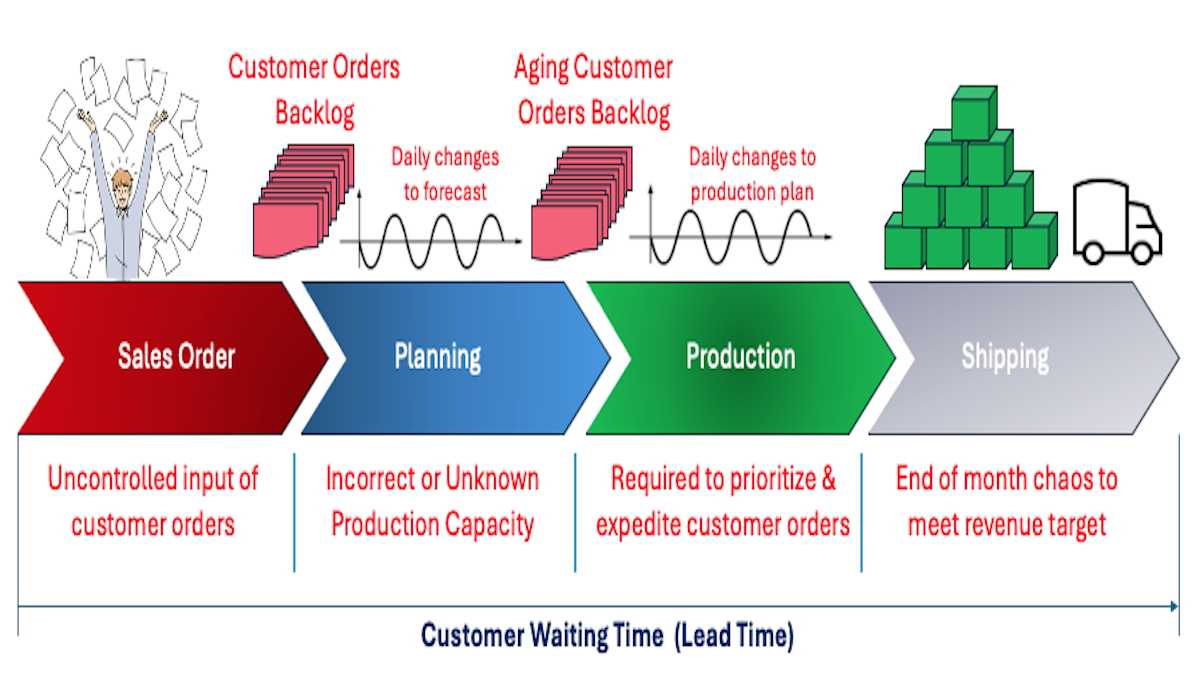The Invisible BottleNeck

The Invisible Bottleneck: When a Lack of Data Cripples Production Capacity
Imagine a ship sailing without a reliable map or instruments. The captain can guess the direction, but navigating efficiently and avoiding obstacles becomes a matter of luck rather than strategy. This analogy aptly describes a production system operating without clear data on its inherent capacity. Without this fundamental understanding of how much your production operations can realistically handle, the entire system becomes reactive and prone to bottlenecks.
The absence of data regarding production capacity acts as an invisible bottleneck right at the entry point of your system. Sales teams, unaware of the true limitations of production, continue to accept incoming orders without a clear understanding of whether these demands can be met in a timely manner. This disconnect between sales acquisition and production capability is the first domino in a cascade of inefficiencies.
Uncontrolled Order Intake: Setting the Stage for Backlogs
When incoming sales orders aren't metered or controlled to align with actual production demand, the inevitable consequence is a growing backlog of customer orders. This backlog isn't just a number on a spreadsheet; it represents delayed gratification for your customers, increased pressure on your production teams, and a potential strain on customer relationships. The inability to manage the flow of orders creates an immediate imbalance, setting the stage for further complications down the line.
The Daily Fire Drill: Reactive Planning and Shifting Priorities
The lack of foresight caused by insufficient capacity data permeates the production planning and forecasting process. Instead of operating with a stable, forward-looking plan, your team is likely engaged in a constant state of flux. The daily changes and updates to the production schedule are a symptom of trying to fit an unmanageable volume of orders into a finite production capacity.
The practice of prioritizing customer orders based solely on revenue totals further exacerbates this instability. While seemingly driven by a desire to maximize immediate returns, this approach creates a two-tiered system where smaller, but potentially equally important, orders are consistently pushed into the backlog. This not only frustrates those customers with smaller order values but also disrupts the planned flow of production, leading to inefficiencies as resources are constantly shifted to accommodate high-revenue priorities. The predictable outcome is increased setup times, interrupted workflows, and ultimately, lower overall throughput.
The Hockey Stick Effect: A Symptom of Systemic Inefficiency
The culmination of these data-driven deficiencies often manifests as the dreaded "hockey stick" effect at the end of each month. Driven by the pressure to meet revenue targets, the production team is forced into a frantic push to complete as many orders as possible, regardless of efficiency or optimal resource allocation. This period of intense activity is usually preceded by a period of relative calm, creating a highly volatile and unsustainable work environment.
This end-of-month scramble leads to several negative consequences:
- Increased Errors and Reduced Quality: The pressure to meet deadlines often leads to rushed work, increasing the likelihood of errors and compromising product quality.
- Overtime and Increased Labor Costs: To meet targets, production teams are often required to work overtime, leading to higher labor costs and potential burnout.
- Strained Resources: Equipment may be pushed beyond its optimal operating capacity, increasing the risk of breakdowns and maintenance issues.
- Disrupted Future Planning: The focus on immediate output leaves little time for proactive planning and process improvement for the following month.
The Customer Pays the Price: Longer Lead Times and Dissatisfaction
Ultimately, the customer bears the brunt of these internal inefficiencies. The inability to accurately predict production capacity and manage order flow translates directly into longer lead times. Customers are forced to wait longer for their products, leading to frustration, dissatisfaction, and potentially the loss of future business to competitors with more reliable delivery schedules. In today's competitive landscape, where speed and reliability are key differentiators, these extended lead times can severely damage your reputation and erode customer loyalty.
Breaking the Cycle: The Path Towards Efficiency
Addressing these deep-rooted inefficiencies requires a fundamental shift towards a data-driven approach to production management. The first crucial step is to invest in systems and processes that can accurately capture and analyze data related to your production operations. This includes:
- Tracking Production Output: Implementing systems to monitor the output of each stage of the production process, identifying bottlenecks and areas of underutilization.
- Analyzing Cycle Times: Measuring the time taken to complete each production task to understand the true capacity of individual operations.
- Monitoring Resource Availability: Tracking the availability of key resources, including labor, equipment, and materials, to identify potential constraints.
- Forecasting Demand Accurately: Utilizing historical sales data, market trends, and customer insights to develop more accurate demand forecasts.
Once this data is available, it can be used to:
- Determine Realistic Production Capacity: Gaining a clear understanding of the maximum output your system can sustainably achieve.
- Implement Order Metering: Controlling the intake of new orders to align with the identified production capacity, preventing the build-up of excessive backlogs.
- Develop Stable Production Plans: Creating realistic and achievable production schedules based on actual capacity and forecasted demand.
- Optimize Order Prioritization: Implementing a more balanced approach to order prioritization that considers not only revenue but also factors like customer importance and order lead time.
- Proactively Manage Resources: Allocating resources effectively to prevent bottlenecks and ensure smooth production flow.
By embracing a data-driven culture and implementing these changes, you can move away from the reactive chaos of daily fire drills and the end-of-month scramble. This shift will lead to a more stable, predictable, and efficient production system, ultimately resulting in happier customers, more engaged employees, and a healthier bottom line. The journey begins with recognizing the invisible bottleneck created by a lack of data and taking concrete steps to illuminate the true capacity of your production operations
Categories: : Training
 Christopher Turner
Christopher Turner 